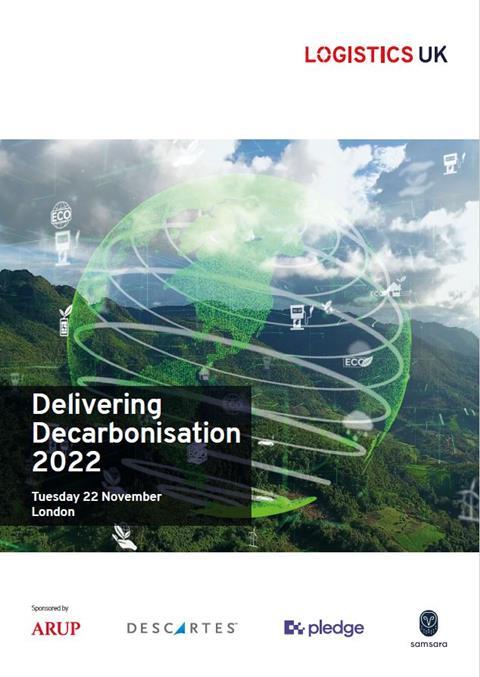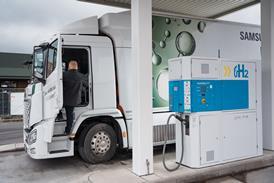Delegates attending the Delivering Decarbonisation Conference organised by Logistics UK in November were treated to a packed programme of presentations covering a broad range of topics and practical advice and case studies.
Head of Decarbonisation Strategy at the Department for Transport, Bob Moran, had just returned from the COP27 environmental summit in Egypt when he took to the podium. As well as giving delegates an update on the direction of travel from UK government “we will electrify everything with wheels”, he explained how one of the biggest breakthroughs for transport at the global climate summit was the USA’s commitment to the Global Memorandum of Understanding on Zero-Emission Medium and Heavy-Duty Vehicles.

“I know it’s only a pledge and isn’t a regulation, but it is a very significant step,” Moran explained. The MOU aligns countries around a joint ambition for ZE-MHDVs, aiming for 30% new MHDVs being zero emissions by 2030, and 100% by 2040, so as to facilitate net-zero carbon emissions by 2050.
Moran went on to explain the government’s Zero Emission Road Freight Demonstration (ZERFD) project, to fund operational trials of vehicles, remains on course to announce its funding allocations before Christmas. These trials will be crucial in understanding the infrastructure requirements for the UK logistics sector, he explained.
In a lengthy Q&A session, Moran confirmed the UK does not have the regulation in place to implement the proposed Euro-7 emissions rules, nor is it expected that VECTO (Vehicle Energy Consumption calculation Tool), the attempt by the EU to create a whole vehicle value for CO2 emissions, will be adopted by the UK.
From government strategy, the conference attention turned to energy and infrastructure. Peter White, system development engineer at Western Power Distribution, now part of National Grid, repeated the message delegates had received from National Grid’s Graeme Cooper at the Motor Transport Decarbonisation Summit earlier in the month, to engage early with the DNOs in order to secure your connection. To illustrate the growing demand, Russell Fowler, senior project manager for transport decarbonisation at National Grid explained they had seen a 400% increase in applications for connection.
In a candid presentation, Andrew New Close Brothers’ head of national accounts and ESG explained the challenges the finance sector is facing as it seeks to support the logistics industry on its decarbonisation journey. “Funders are in a similar position to most in the sector,” he said, “everything we thought we knew [about asset funding vehicles] is obsolete as we shift to electrification of trucks. It is essential the finance community steps forward and supports the sector, but the cost and uncertainty is enormous.”
Plotting the future residual values of carbon zero trucks was virtually impossible, he added, “we have no idea what the five-year value of these vehicles will be.”
Moving forward New said the finance sector would require early manufacturer support to prime the market, whether that was through buybacks or support for enhanced end of term balloon payments. “No funder will take the sole risk without support,” he said, while also adding the traditional funding approach was changing, with pay per use emerging as a new model. “This will require collaboration between the energy provider, vehicle OEM and the funder,” he concluded.
After lunch, attention shifted to more practical advice for operators, with a typically lively presentation from Tim Campbell, owner at Campbell Consulting. Campbell took the audience through a tour of the key issues operators needed to be aware of as they switched carbon zero vehicles, particularly around vehicle connectivity to the grid: “Match your vehicles to the charging infrastructure, not the other way round,” he explained, warning there could be costly errors in buying vehicles that aren’t compatible with the charging systems installed. He also urged operators to ensure they were specifying bi-directional batteries in those vehicles, which would permit batteries to feedback into the grid (or other networks) when required.
The final session of the day focused on the last mile with Nancy Hobhouse, head of ESG at Evri. She gave an overview of the steps the parcel giant is taking to hit its net zero by 2035 target. 40% of the long-haul tractor unit fleet is now running on HVO, she explained, while final mile presents more of a challenge.
“We have three main areas where we can impact {the carbon emissions of] our last mile deliveries,” Hobhouse said. “Out of Home, where we now have 6000 delivery and collection points [where consumers can collect their own consignments] reducing delivery miles. Secondly, we’re using e-cargo bikes for inner city and are operational in Bristol, Edinburgh and London. Finally, the self-employed courier network – we have 30,000 couriers.” Hobhouse explained just 2% of the couriers were currently using electric vans at Evri, with capital costs and thereby leasing rates being the major barrier to adoption.













